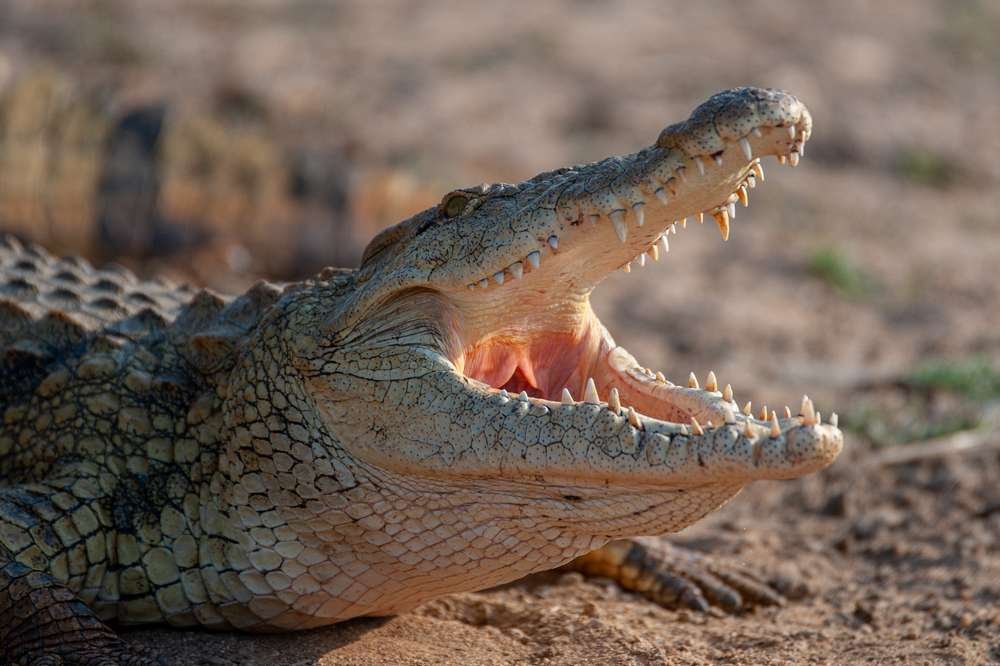Nile Crocodile
( Kwena (Lozi) or ing'wena (Bemba) )
- Crocodylus niloticus
- IUCN Status: Least Concern
- Threat: Very deadly
- Venom/Toxin: none
- Trend: decreasing

- Phylum: Chordata
- Class: Reptilia
- Order: Crocodilia
- Family: Crocodylidae
- Genus: Crocodylus
Share:
General Information
The Nile crocodiles are well known and can be found throughout Africa. The scientific name, Crocodylus niloticus was derived from greek words that translate to, “pebble worm from the Nile river”.
Fun Facts!
The crocodile is the only reptile that shows any maternal instinct as both parents stay with their young until they are big enough. They can hide their hatchlings inside their mouths to protect them when danger is near. Nile crocodiles have a Top-Speed of up to 35.4056 km/h (9.835 m/s). They are the largest freshwater crocodile in Africa and Second largest crocodile in the world. Nile crocodiles have the 3rd strongest bite force in the world at 3000 psi ( 2267.96 kg of force) or (22,000 N). Their bite-force is beaten only by the Great white shark (4000 psi) and the saltwater crocodile (3700 psi). The phrase, “to cry crocodile tears” comes from the fact that they do it to get rid of excess salt and not because they cry out of sadness.
Description
The nile crocodile is an iconic very large scaly reptile. Its camouflage dark brown/olive hard and rough scaly skin is covered in scales and it has a very large mouth which gives it a powerful bite filled with conical teeth. It has a long tail for swimming and maneuverability and four small limbs. The underbelly of young crocodiles is yellowish green. As they mature, Nile crocodiles become darker and the cross-bands fade. The nostrils, eyes, and ears are situated on the top of the head, so the rest of the body can remain concealed under water.
- Length: avg 2.94 - 4.4 m (though they can grow much larger)
- Weight: avg 225 - 414.5 kg (though they can grow to be heavier than 1000kg)
- Lifespan: 45 yrs
Ecology and Behaviour
Nile crocodiles are generally inert creatures and can, if not disturbed, spend the hours from 9:00 a.m. to 4:00 p.m. continuously basking with their jaws open if conditions were nice and sunny. If their jaws are bound together in the extreme midday heat, Nile crocodiles may easily die from overheating. Even though they can be motionless at times while basking, they are completely aware of their surroundings and other animals.
Diet
Nile crocodiles are apex predators throughout their range. In the water, this species is an agile and rapid hunter relying on both movement and pressure sensors to catch any prey unfortunate enough to present itself inside or near the waterfront. On land they rely on their limbs to gallop as they chase their prey. The Nile crocodile mostly hunts within the confines of waterways, attacking aquatic prey or terrestrial animals when they come to the water to drink or to cross. The crocodile mainly hunts land animals by almost fully submerging its body under water. Occasionally, a crocodile quietly surfaces so that only its eyes (to check positioning) and nostrils are visible, and swims quietly and stealthily toward its mark. The attack is sudden and unpredictable. Crocodile teeth are not used for tearing up flesh, but to sink deep into it and hold on to the prey item. The immense bite force, which may be as high as 2267.96 kg of force (22,000 N) in large adults, ensures that the prey item cannot escape the grip.
Reproduction
In September, when the water is low, the female will dig a hole and deposit between 45 and 90 eggs, perfectly timed to hatch before the river rises and floods the nest site 3 months later. She will guard the nest site against predators (monitor lizard, honey badger and even hyaena). After three months the young emit a small squeaking sound from the eggs. She then removes the topsoil which they would be unable to penetrate without her help.
The unborn young have a bony tip on their snouts, to help them cut through the tough shell, which soon after birth is absorbed and disappears. As they break through the shell she collects them in her mouth and carries them to water. Even though she continues to care for them for several weeks after hatching, only one percent are likely to reach maturity.
Conservation
It is categorized by the International Union for Conservation of Nature (IUCN) as, “Least Concern”
Distribution and Habitat
In Zambia, they are common on every major rivers, flood plains, lakes etc. They can be found almost throughout Africa (at least 70% of the continent)
Interaction with humans
There is a lot of animosity toward Nile crocodiles that stems from their reputation as a man-eaters and that is not unjustified. Crocodiles are dangerous and fishermen are well aware and take precaution to avoid crocodile infested areas. Most fatal attacks occur when a person is standing a few feet away from water on a non-steep bank, is wading in shallow waters, is swimming or has limbs dangling over a boat or pier. Many victims are caught while crouching, and people in jobs that might require heavy usage of water, including laundry workers, fisherman, g6ame wardens and regional guides, are more likely to be attacked
No donation to this project yet.
| M | T | W | T | F | S | S |
|---|---|---|---|---|---|---|
| 1 | 2 | 3 | 4 | 5 | 6 | 7 |
| 8 | 9 | 10 | 11 | 12 | 13 | 14 |
| 15 | 16 | 17 | 18 | 19 | 20 | 21 |
| 22 | 23 | 24 | 25 | 26 | 27 | 28 |
| 29 | 30 | 31 | ||||


